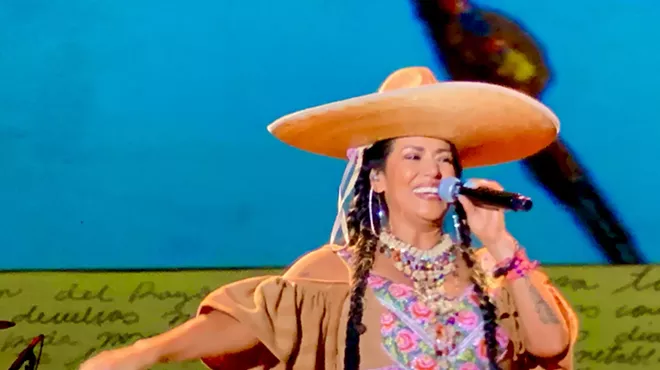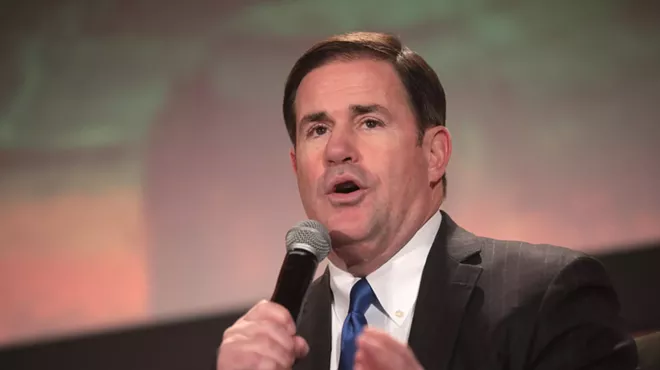Wednesday, August 19, 2015
What's the Future of Downtown's Citizens Warehouse?
Long, long ago, the Arizona Department of Transportation bought a bunch of downtown warehouses along the railroad tracks with the intention of demolishing them—along with the El Presidio Neighborhood—for a highway that thankfully never happened.
While the warehouses sat vacant, a bunch of artists started renting them out, creating an organic arts district. In more recent years, ADOT has been selling off the warehouses at auction. But it still owns the Citizens Warehouse along where the railroad tracks cross Sixth Street just west of Stone Avenue.
Citizens Warehouse is home to a wonderful bunch of artists—Nick Georgiou, Rand Carlson, Dirk Arnold and many others—who are producing great work that's now on display at Etherton Gallery. And this Friday, August 21, the gallery will host a panel discussion on the past, present and future of the Citizens Warehouse with state Sen. Steve Farley, Demion Clinco of the Tucson Historic Preservation Foundation,longtime downtown arts advocate David Aguirre and others. It's sure to be a great discussion if you're into history, arts or Tucson's future—and if you haven't seen the terrific Artists of Citizens Warehouse show, here's a chance to check that out. Here are the details from Etherton:
In conjunction with its exhibition, The Artists of Citizens Warehouse, Etherton Gallery is pleased to present a community panel discussion addressing the past, present and future of the Citizens Warehouse.
Designed by Roy Place (1887-1950), who designed several buildings on the University of Arizona campus, and the iconic Pima County Courthouse, the Citizens Warehouse is listed on the National Register of Historic Places. It was slated for demolition in 1985, but through the efforts of numerous government officials, leaseholders, artists and others, it was saved from destruction.
Now owned by Arizona Department of Transportation (ADOT), it is home to over 20 artists whose work is currently on display at Etherton Gallery. Although artists have brought thousands of Tucsonans and tourists downtown over the years, garnering tremendous publicity for the area and contributing to its revitalization and economic growth, the Citizens Warehouse, may still face threats from on going development opportunities downtown.
The panel will address the history and preservation of the Citizens Warehouse.
Distinguished panel members will include: Arizona State Senator for Tucson’s District 9, Steve Farley; Demion Clinco, Executive Director of the Tucson Historic Preservation Foundation; Corky Poster, Architect and Professor Emeritus of the University of Arizona College of Architecture, Planning, and Landscape Architecture; James W. Glock, former Director of Transportation for the City of Tucson and President of Board of the Tucson Pima Arts Council (TPAC) and Acting President of the Warehouse Management Organization (WAMO); David Aguirre, Executive Director of Dinnerware Artspace, and former leaseholder of the Citizens Warehouse; and Discussion Moderator Alec Laughlin, President of the Citizens Artist Collective.
We look forward to an active discussion regarding historic warehouse buildings, affordable artist spaces and creative leasing opportunities for groups like the Citizens Artist Collective.
7pm, Friday, August 21, 2015 at Etherton Gallery.
For information call (520) 624-7370 or email the gallery at info@ethertongallery.com.
Panelist Biographies
Steve Farley
Serving his fifth term in elected office, Arizona State Senator, Steve Farley represents Tucson's District 9 in the Arizona State Senate. He was first elected in 2006 to represent the citizens of District 28 in the Arizona House of Representatives, where he served three terms. His legislative priorities include jobs and economic development, education, senior issues, public safety, transportation choices, sustainable growth, fiscal health, and quality of life. In the House of Representatives, Farley worked to invest in new technologies and high-wage jobs, expand health care for self-employed and small-business owners, make long-term care more affordable for middle-class seniors, increase the production of clean solar energy, outlaw driving while texting, build passenger rail between Tucson and Phoenix and beyond, protect Tucson’s sovereignty, and create livable communities. Farley has been honored numerous times with the highest awards given by the Arizona League of Conservation Voters as well as the Arizona League of Towns and Cities. Farley is a strong advocate for public transit and transportation improvements, and is the founder of Southern Arizona Transit Advocates. He was instrumental in gaining approval for a comprehensive regional transportation system of roads, buses, bikeways and sidewalks, and the Modern Streetcar starter light rail line, which created hundreds of jobs and more than $500 million in private construction projects within three blocks of its route during the worst recession Arizona has seen. His leadership at the Regional Transportation Authority (RTA) has resulted in thousands of new, good jobs and rebuilt vital Tucson regional roadways like La Cholla and La Canada. In 2011 the Arizona Transit Association awarded him the Friend of Transit award, and the Arizona Chapter of the American Planning Association named him Distinguished Elected Official.
Farley is also a public artist and is best known for gathering personal photos from the Tucson community and transforming them into the photographic tile murals that line the Broadway Underpass, at the eastern gateway to Downtown Tucson. This work was named Best Mural in the Tucson Weekly’s annual Best of Tucson readers poll eleven years in a row. For that project, he invented a new way of converting photographs to glazed ceramic tile, and he has since completed numerous mural projects around the U.S. Steve Farley remains close to his roots and serves as a Board Member of the Blenman Elm Neighborhood Association.
Demion Clinco
Demion Clinco has been involved in state, local and national public policy issues relating to historic preservation and cultural resources for over ten years. Currently, he is the Executive Director of the Tucson Historic Preservation Foundation. In 2014-2015, Clinco served in the Arizona House of Representatives. From 2007 to 2014, he served as a mayoral appointee on the Tucson-Pima County Historic Commission. Since 2010 he has served as the Arizona State Advisor to the National Trust for Historic Preservation, becoming Vice-Chair in 2014, representing the Western Region. Clinco is a member of the Board of Directors of Archeology Southwest, the Arizona Preservation Foundation, a founding member of the Arizona Vintage Sign Coalition, and in 2011, led the creation of Tucson Modernism Week. Demion Clinco is a member of the Southern Arizona Leadership Council, and has received numerous awards and fellowships in the field of architectural and heritage preservation.
Corky Poster
An alumnus of the Harvard Graduate School of Design, Corky founded Poster Frost Mirto in 1983 as Corky Poster Architect. Over the last thirty years he has received wide acclaim for his grass roots urban design and community-based architecture, and for pioneering an integrated approach to historic preservation planning. He is a Professor Emeritus of the University of Arizona College of Architecture, Planning, and Landscape Architecture, former Director of the Drachman Institute, and former Acting Dean of the UA CAPLA. Poster is currently the Vice President of the Living Streets Alliance and Vice-President of the Board of the Tucson Pima Arts Council.
James W. Glock
James W. Glock has over 30 years experience in managing and directing large scale transportation projects. He served as the Transportation Director for the City of Tucson for over nine years, retiring in December 2011. During his career at the City of Tucson, he was involved in the planning, design and/or construction of numerous transportation corridor and transit capital improvement projects including: Grant Road Improvement Plan, Downtown Links, Tucson Modern Streetcar, Tohono Tadai Transit Center, Sun Tran Maintenance Facility, Van Tran Maintenance Facility, Stone Avenue Corridor Study, 5th/6th Street Corridor Study, Oracle Road/South Sixth Avenue Corridor Study, and the Broadway Corridor Transitional Analysis. In addition, he has overseen the operations of Sun Tran and Van Tran through a transit management contract. This effort included addressing on-street infrastructure as well as operational planning such as the preparation of short range transit plans, implementation of an Automated Vehicle Location system and the oversight of a comprehensive operational analysis. He was also involved in the planning, design and/or construction of numerous bridges including: Golf Links Road over the Pantano Wash, Silverlake Road over the Santa Cruz River, Diamondback Pedestrian and Bicycle Bridge at the Broadway TI, Basket Pedestrian and Bicycle bridge at Park Avenue, and the 4th Avenue Railroad Underpass. As the Design Manager for Structural Grace, he is responsible for client relations, project management and design. Glock is President of the Board of Directors of the Tucson Pima Arts Council (TPAC) and Acting President of the Warehouse Management Organization (WAMO) of Tucson.
David Aguirre
David Aguirre has been involved in promoting Tucson’s artists for over 20 years and currently serves as the Executive Director of Dinnerware Artspace. In the early 1990s, Aguirre helped rehabilitate the “boarded-up” Citizens Warehouse, bringing together a group of artists and the Arizona Department of Transportation (ADOT) together to lease the building and construct artist studios. He initially assumed the lease and embarked on a massive rehabilitation project, doing much of the work himself. Aguirre’s entrepreneurship has brought thousands of Tucsonans downtown to engage with the arts through projects such as: “Let Them Eat Cupcakes,” an interactive performance art and installation work about hunger in the United States; “Ignite Tucson” in which fifteen creatives give a five-minute, 20-image presentation on an thought provoking topic; “Night of a Thousand Drawings,” which encouraged artists as well as members of the public to donate a small work which was displayed on a clothesline and offered for sale; “SlideShark” which presented short iMovies made through the collaboration of artists and DJs. In the “Eat Dinner-Fund an Artist” event, the public was invited to a $20 dinner where six artists made five-minute presentations about their work, everyone voted and the winning artist received $500.) Aguirre’s most recent ventures include a mobile art gallery known as “Planet Rabbit” and “Food Truck Roundups” started in 2011.
(Credit: Craig Bellman, http://3storymagazine.com/david-aquirre)
Moderator
Alec Laughlin
Since 2012, Alec Laughlin has served as the President of the Board of Directors of the Citizens Artist Collective, a nonprofit organization, which was established to support the 24 artists who share studio space at the Citizens Warehouse in downtown Tucson. The Citizens Artist Collective is committed to the preservation of the Citizens Warehouse for use as affordable artist studio space. Laughlin helped organized Etherton Gallery’s summer 2015 exhibition, the Artists of Citizens Warehouse. He works in multiple media including photography, painting, web and graphic design, writing and publishing. In 2013, he established the fine art publishing house, Eponymous Atelier. The first Eponymous Atelier effort, Citizens Warehouse (2013), was a Southwest Book of the Year.










